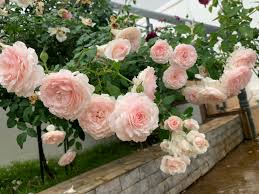### The Development of the Pompadour Rose and Its Measurement

#### Introduction to the Pompadour Rose
The Pompadour Rose, a timeless symbol of elegance and beauty, has undergone a fascinating journey of development and refinement over the years. From its humble origins to its current status as a beloved icon of the rose world, the Pompadour Rose continues to captivate flower enthusiasts with its exquisite form, fragrance, and color. In this exploration, we delve into the history of the Pompadour Rose and the methods used to measure and evaluate its growth and characteristics.
#### Origins and Evolution
The history of the Pompadour Rose traces back to the 18th century, when it was first cultivated in France during the reign of King Louis XV. Named in honor of Madame de Pompadour, the influential mistress of the king and a renowned patroness of the arts, the Pompadour Rose quickly gained popularity for its delicate beauty and enchanting fragrance. Over the centuries, rose breeders and horticulturists have continued to refine and hybridize the Pompadour Rose, creating new varieties with enhanced traits and characteristics.
#### Hybridization and Selection
The development of the Pompadour Rose involves a meticulous process of hybridization and selection, aimed at creating roses with desirable traits such as color, fragrance, bloom size, and disease resistance. Rose breeders carefully cross-pollinate different rose varieties to create new hybrids, selecting the best offspring for further propagation and cultivation. Through generations of selective breeding, the Pompadour Rose has evolved to exhibit a wide range of colors, shapes, and fragrances, each reflecting the unique vision and expertise of its creators.
#### Measurement and Evaluation
The growth and characteristics of the Pompadour Rose are evaluated using a variety of quantitative and qualitative measures, allowing breeders and horticulturists to assess its performance and potential. Some of the key parameters used to measure the Pompadour Rose include:
1. **Plant Height:** The height of the Pompadour Rose plant is an important indicator of its vigor and growth habit. Taller plants may produce more blooms and foliage, while shorter plants may be more compact and suitable for smaller garden spaces.
2. **Bloom Size:** The size of the blooms produced by the Pompadour Rose can vary widely depending on the variety. Large, showy blooms are often prized for their visual impact, while smaller blooms may be valued for their abundance and longevity.
3. **Color:** The color of the Pompadour Rose blooms is a key factor in its aesthetic appeal and marketability. Roses come in a wide range of colors, including pink, red, white, yellow, and lavender, with each hue evoking different emotions and associations.
4. **Fragrance:** The fragrance of the Pompadour Rose is another important characteristic that is carefully evaluated by breeders and enthusiasts. Roses can exhibit a wide range of scents, from sweet and floral to spicy and musky, with each fragrance adding to the overall sensory experience of the rose.
5. **Disease Resistance:** The Pompadour Rose is evaluated for its resistance to common rose diseases such as black spot, powdery mildew, and rust. Roses that exhibit strong disease resistance are less likely to require chemical pesticides and fungicides, making them more environmentally friendly and sustainable.
#### Modern Techniques and Technologies
Advances in modern techniques and technologies have revolutionized the way the Pompadour Rose is measured and evaluated. DNA analysis and molecular markers allow breeders to identify desirable traits and select for them more efficiently, speeding up the breeding process and reducing the need for traditional trial-and-error methods. Additionally, computer modeling and simulation techniques enable researchers to predict the performance of new rose varieties under different growing conditions, helping to optimize cultivation practices and maximize yields.
#### Conclusion: A Legacy of Beauty and Innovation
In conclusion, the Pompadour Rose represents a legacy of beauty and innovation in the world of roses. From its origins in the royal gardens of France to its continued evolution in the hands of modern breeders, the Pompadour Rose continues to enchant and inspire with its exquisite form, fragrance, and color. By employing a combination of traditional breeding techniques and cutting-edge technologies, rose enthusiasts and horticulturists alike are able to measure and evaluate the growth and characteristics of the Pompadour Rose with greater precision and insight than ever before. As we continue to honor and celebrate the rich heritage of the Pompadour Rose, let us also embrace the spirit of innovation and discovery that propels it forward into a bright and beautiful future.
### The Development of the Pompadour Rose and its Measurement (Part 2)
#### Evolution through Generations
The development of the Pompadour Rose is a story of continuous evolution and refinement, spanning generations of dedicated rose breeders and horticulturists. Through careful selection, hybridization, and cultivation practices, the Pompadour Rose has evolved to exhibit a wide range of characteristics and traits, each contributing to its enduring appeal and popularity.
#### Selection Criteria
When evaluating the growth and characteristics of the Pompadour Rose, breeders and horticulturists consider a variety of factors to determine its suitability for cultivation and commercialization:
1. **Vigor:** The vigor of the Pompadour Rose plant is a key consideration, as it affects its overall health, growth rate, and ability to withstand environmental stressors. Vigorous plants are more resilient and productive, producing larger blooms and foliage.
2. **Resistance to Disease:** Disease resistance is an important trait in the Pompadour Rose, as it can help to reduce the need for chemical pesticides and fungicides. Roses that exhibit strong resistance to common diseases such as black spot, powdery mildew, and rust are favored for cultivation.
3. **Bloom Characteristics:** The size, shape, and color of the blooms produced by the Pompadour Rose are carefully evaluated for their aesthetic appeal and marketability. Large, showy blooms with vibrant colors are often preferred, as they command attention and make a bold statement in the garden or floral arrangements.
4. **Fragrance:** Fragrance is another important consideration when evaluating the Pompadour Rose, as it enhances the sensory experience of the flower. Roses with strong, sweet, and pleasing scents are highly prized for their fragrance, adding to their overall allure and desirability.
5. **Longevity:** The longevity of the blooms produced by the Pompadour Rose is an important factor for both growers and consumers. Roses that have a long vase life and remain fresh and vibrant for extended periods are valued for their durability and shelf appeal.
#### Measurement Techniques
Several techniques and methods are used to measure and evaluate the growth and characteristics of the Pompadour Rose:
1. **Visual Inspection:** Visual inspection is the most straightforward method of evaluating the Pompadour Rose, allowing breeders and horticulturists to assess its overall appearance, health, and vigor. By observing factors such as plant size, foliage density, bloom size, color, and fragrance, experts can make informed decisions about the suitability of a particular variety for cultivation.
2. **Quantitative Analysis:** Quantitative analysis involves the measurement of specific parameters such as plant height, bloom size, petal count, and fragrance intensity using standardized instruments and techniques. These measurements provide objective data that can be used to compare different rose varieties and track changes over time.
3. **Sensory Evaluation:** Sensory evaluation involves subjective assessments of the Pompadour Rose’s fragrance, appearance, and overall aesthetic appeal by trained panels of experts or consumers. These evaluations provide valuable insights into the sensory attributes of the rose and its perceived quality and desirability.
4. **Laboratory Analysis:** Laboratory analysis may be used to assess the chemical composition of the Pompadour Rose, including its fragrance compounds, pigments, and nutritional content. Techniques such as gas chromatography, mass spectrometry, and high-performance liquid chromatography can provide detailed insights into the biochemistry of the rose and its potential health benefits.
#### Future Directions
As technology advances and our understanding of rose genetics and physiology deepens, new methods and techniques for measuring and evaluating the Pompadour Rose will continue to emerge. From precision breeding techniques such as genome editing to high-throughput phenotyping platforms, these innovations hold the promise of accelerating the development of new rose varieties with enhanced traits and characteristics. By embracing these advancements and leveraging the power of science and technology, we can ensure that the Pompadour Rose remains a cherished symbol of beauty, elegance, and excellence for generations to come.
#### Conclusion: A Legacy of Excellence
In conclusion, the development of the Pompadour Rose is a testament to the dedication, ingenuity, and passion of rose breeders and horticulturists around the world. Through centuries of careful selection, hybridization, and cultivation practices, the Pompadour Rose has evolved into a masterpiece of nature, captivating hearts and minds with its exquisite beauty and timeless charm. By employing a combination of traditional techniques and modern innovations, we can continue to measure and evaluate the growth and characteristics of the Pompadour Rose with precision and insight, ensuring its continued success and prominence in the world of roses. As we celebrate the legacy of the Pompadour Rose, let us also look to the future with optimism and excitement, embracing new opportunities for innovation and discovery in the quest to unlock the full potential of this iconic flower.


